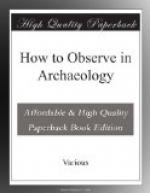Surface indications of buried buildings (or rather foundations) may be noted both on the top and on the sides of a tell. Lines of wall may not infrequently be traced. Often the vegetation growing on the surface indicates the presence of structures underneath (either by burnt-up patches amid luxuriant growths, or vice versa).
4. Surface exploration of a khirbet. The task here is, generally sneaking, simpler. In a khirbet there is usually no great depth of accumulation; indeed, the bare rock frequently crops up in the middle of such a site. There is, therefore, as a rule only one historical period represented. Potsherds, coins (Roman, Jewish, Byzantine, early Islamic, sometimes Crusader), tesserae of mosaic pavements, fragments of iron nails, beads, minute metal ornaments (as bronze wire finger-rings) are to be picked up on khirbet sites.
The remains of walls are usually more easily traceable in khirbet than in tell sites, though much damage has been done by quarrying for modern buildings. These walls should be carefully examined: buildings other than mere houses (churches, synagogues, baths) may sometimes be detected. Cisterns should be noted. Some of these are not very obvious and the traveller should be on his guard against falling into them.
All stones should be examined, as there is a chance of finding inscriptions.
5. In all work on ancient sites the investigator must make a point of noting everything, irrespective of its apparent importance, and of carefully training a critical judgement in interpreting his observations. It is impossible to lay down general principles that govern every case completely: every site presents its own individual problems.
III. Rock-cut Tombs.
1. All Palestine is honeycombed with rock-cut tombs, which form a fascinating and inexhaustible field of study. Unfortunately all that are in the least degree visible have long ago been rifled, and in recent years those pests, the curio-hunting tourists, have done incalculable harm by stimulating the native tomb-robber and dealer.
2. The explorer of rock-cut tombs must be indifferent to mud, damp, evil smells, noxious insects, and other discomforts, and he must be prepared to squeeze through very narrow passages, much clogged with earth. He is recommended to be on his guard against scorpions and snakes.
3. A plan and vertical section of the tomb should be drawn. The measurements should be taken carefully, not only for the sake of the accuracy of the plan, but also for metrological purposes.
4. The rock outside the entrance of the tomb-chamber should be examined. It often shows rebating or other cutting, designed to receive the foundations of a masonry mausoleum (resembling in general style the rock-hewn monuments in the Kedron Valley at Jerusalem). As a rule such structures have been entirely destroyed for the sake of their stones.




